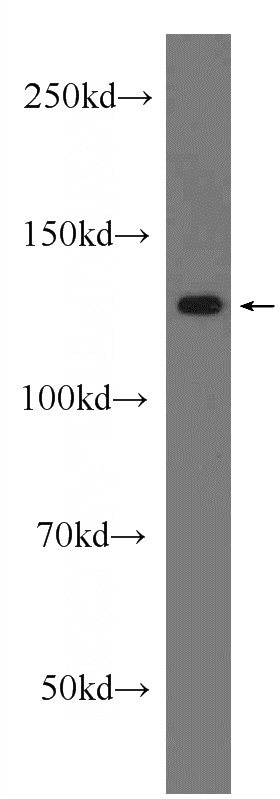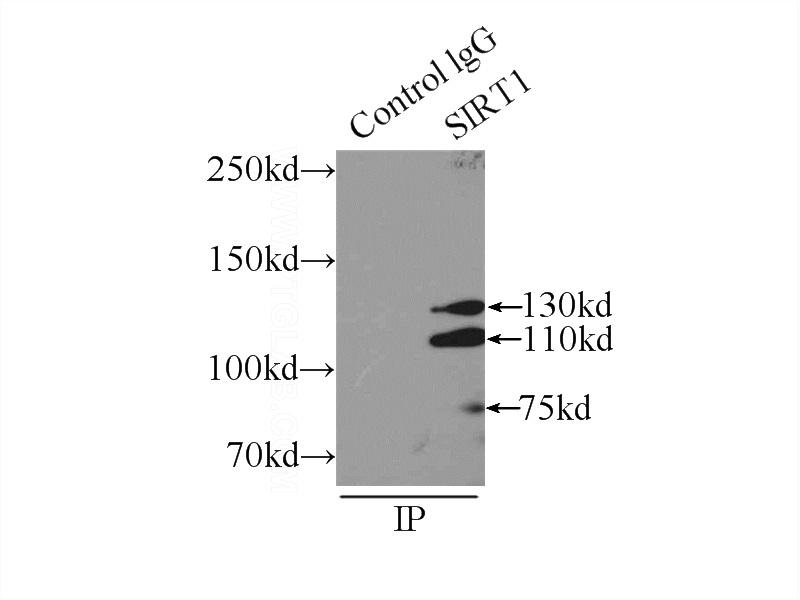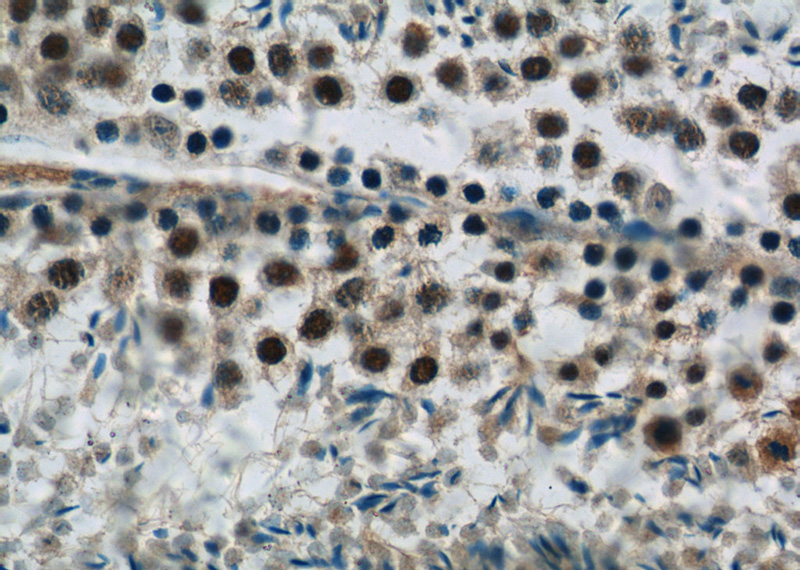-
Product Name
SIRT1 antibody
- Documents
-
Description
SIRT1 Rabbit Polyclonal antibody. Positive WB detected in HeLa cells, DU 145 cells, HEK-293 cells, Jurkat cells, K-562 cells, MCF7 cells, mouse testis tissue, PC-3 cells. Positive IP detected in mouse testis tissue. Positive IHC detected in mouse testis tissue, human colon cancer tissue, human lung cancer tissue. Observed molecular weight by Western-blot: 110-130 kDa,80-85 kDa
-
Tested applications
ELISA, IP, IHC, WB
-
Species reactivity
Human,Mouse,Rat; other species not tested.
-
Alternative names
hSIR2 antibody; hSIRT1 antibody; SIR2 like protein 1 antibody; SIR2L1 antibody; SIRT1 antibody
-
Isotype
Rabbit IgG
-
Preparation
This antibody was obtained by immunization of SIRT1 recombinant protein (Accession Number: BC012499). Purification method: Antigen affinity purified.
-
Clonality
Polyclonal
-
Formulation
PBS with 0.02% sodium azide and 50% glycerol pH 7.3.
-
Storage instructions
Store at -20℃. DO NOT ALIQUOT
-
Applications
Recommended Dilution:
WB: 1:200-1:2000
IP: 1:200-1:2000
IHC: 1:20-1:200
-
Validations

HeLa cells were subjected to SDS PAGE followed by western blot with Catalog No:115241(SIRT1 Antibody) at dilution of 1:800

IP Result of anti-SIRT1 (IP:Catalog No:115241, 4ug; Detection:Catalog No:115241 1:500) with mouse testis tissue lysate 8000ug.

Immunohistochemistry of paraffin-embedded mouse testis tissue slide using Catalog No:115241(SIRT1 Antibody) at dilution of 1:50 (under 40x lens)
-
Background
SIRT1, also named as SIR2L1, contains a deacetylase sirtuin-type domain and belongs to the sirtuin family. The post-translation modified SIRT1 is a 110 kDa protein, which contains one deacetylase sirtuin-type domain. The 75 kda SirT1 fragment was detected to lack the carboxy-terminus (PMID:21305533). SIRT1 may be found in nucleolus, nuclear euchromatin, heterochromatin and inner membrane. It can shuttles between nucleus and cytoplasm. SIRT1 regulates processes such as apoptosis and muscle differentiation by deacetylating key proteins. SIRT1 in particular initiates several signaling events relevant to cardioprotection, including: activation of endothelial nitric oxide synthase, insulin receptor signaling, and autophagy. In addition SIRT1 activation elicits resistance to oxidative stress via regulation of transcription factors and co-activators such as FOXO, Hif-2a, and NF-kB. SIRT1 regulates the p53-dependent DNA damage response pathway by binding to and deacetylating p53, specifically at Lysine 382. This antibody is a rabbit polyclonal antibody raised against residues near the N terminus of human SIRT1.
-
References
- Endo H, Niioka M, Kobayashi N, Tanaka M, Watanabe T. Butyrate-producing probiotics reduce nonalcoholic fatty liver disease progression in rats: new insight into the probiotics for the gut-liver axis. PloS one. 8(5):e63388. 2013.
- Potteti HR, Rajasekaran S, Rajamohan SB, Tamatam CR, Machireddy N, Reddy SP. Sirtuin 1 Promotes Hyperoxia-induced Lung Epithelial Death Independent of NRF2 Activation. American journal of respiratory cell and molecular biology. 2015.
- Freitas M, Rodrigues AR, Tomada N. Effects of Aging and Cardiovascular Disease Risk Factors on the Expression of Sirtuins in the Human Corpus Cavernosum. The journal of sexual medicine. 12(11):2141-52. 2015.
- Hong W, Xu XY, Qiu ZH. Sirt1 is involved in decreased bone formation in aged apolipoprotein E-deficient mice. Acta pharmacologica Sinica. 36(12):1487-96. 2015.
- Liu F, Zhang W, Yang F. Interleukin-6-stimulated progranulin expression contributes to the malignancy of hepatocellular carcinoma cells by activating mTOR signaling. Scientific reports. 6:21260. 2016.
- Liu L, Wang P, Liu X, He D, Liang C, Yu Y. Exogenous NAD(+) supplementation protects H9c2 cardiac myoblasts against hypoxia/reoxygenation injury via Sirt1-p53 pathway. Fundamental & clinical pharmacology. 28(2):180-9. 2014.
- Tomada I, Negrão R, Almeida H, Neves D. Long-term high-fat consumption leads to downregulation of Akt phosphorylation of eNOS at Ser1177 and upregulation of Sirtuin-1 expression in rat cavernous tissue. Age (Dordrecht, Netherlands). 36(2):597-611. 2014.
- Liang J, Zhang Y, Jiang G. MiR-138 induces renal carcinoma cell senescence by targeting EZH2 and is downregulated in human clear cell renal cell carcinoma. Oncology research. 21(2):83-91. 2013.
Related Products / Services
Please note: All products are "FOR RESEARCH USE ONLY AND ARE NOT INTENDED FOR DIAGNOSTIC OR THERAPEUTIC USE"
